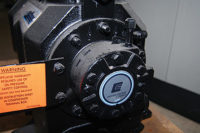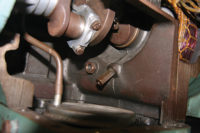Often, systems without good oil separators, or none at all, will have oil build-up points throughout the piping. When manufacturer’s specifications are followed, refrigerant and oil mix with one another in a refrigeration or air conditioning system. The fine oil mist that travels with the refrigerant will usually build up and collect at low points in the system’s piping. Most of the time, the refrigerant vapor will push this slug of oil to the next low spot until the oil finally returns to the compressor. Large oil slugs returning to some compressors can damage valve plates and internal running gear if hydraulic pressure builds too great in the cylinders.
The function of an oil reservoir, commonly known as an oil trap, is to prevent large oil slugs from forming. This is accomplished by trapping a small amount of oil in the reservoir or trap and gradually returning it to the compressor.
How Oil Traps Work
It is the velocity of the refrigerant that carries oil throughout a refrigeration and air conditioning system. As oil clings to the sidewalls of the piping, refrigerant gas velocity sweeps small oil particles away in suspension. This is why refrigeration and/or air conditioning piping should never be oversized. Oversized piping will slow refrigerant velocities, causing poor oil return. As oil collects in the trap, there is a restriction of internal pipe area. This causes the refrigerant gas to travel faster as it passes by the oil lying in the trap. It is this higher-velocity refrigerant that will pick up minute surface droplets of oil out of the trap. The small oil droplets will then be carried either to the compressor or to the next trap. Oil traps are constantly being fed and depleted of oil at a gradual rate. It is this gradual rate that protects compressors from large oil slugs. It is recommended that there be oil traps in all vapor-carrying lines in the system to assure proper oil return.
Risers
Risers are nothing but upward runs of piping that cause the refrigerant to flow upward. If there is oil mixed in with the refrigerant, it will have a tendency to fall back to the bottom of the riser because of the long climb to the top, fighting gravity all the way. This is why there should be a trap at the bottom of the riser. There should also be an oil trap every 15-20 feet of the riser to help temporarily store the oil as it makes its way to the top of the riser because the refrigerant-oil mixture will gradually lose velocity as it climbs.
Function of Oil
The function of oil in a refrigeration system is to:
• Lubricate;
• Deaden noise;
• Transfer heat — cool;
• Reduce friction;
• Minimize mechanical wear; and
• Seal valves — prevent blow-by in valves and other mechanical parts.
Oil usually logs in the evaporator because it is the coldest component with the largest tubes, thus the slowest refrigerant velocity. Oil logged in the evaporator will coat the inner wall of the coil and reduce the heat transfer through the walls. This will cause a loss of capacity and poor performance. The compressor will be robbed of some of its crankcase oil and run with a lower-than-normal oil level. This may score or ruin mechanical parts in the compressor.
Oil that is too viscous will also be hard to return from an evaporator and will surely cause oil logging. Usually, the heat from the defrost heaters will warm and thin the oil in the evaporator so it can be returned to the compressor once the compressor starts up. This will happen only if the right viscosity (thickness) of oil is used.
If a suction line is oversized, the refrigerant velocity will be decreased. This will prevent the oil from moving through the suction line to the compressor’s crankcase. Remember, it is the refrigerant velocity that will move the oil through the refrigeration system’s piping.
Here are ways an evaporator can become oil logged:
• A flooded compressor circulating oil at start up;
• Too much oil in the system;
• System not piped correctly (no oil traps or piping too large);
• Liquid migration during off cycle causing crankcase oil to foam on startups;
• TXV out of adjustment (too little superheat causing a refrigerant-flooded compressor with refrigerant boiling in the crankcase with the oil);
• Not enough defrost periods for low-temperature application machines. Defrosts help return oil by heating and thinning the oil; and
• Wrong type or viscosity of oil. Oil that is too thick will congregate in system piping.
Publication date: 9/1/2014
Want more HVAC industry news and information? Join The NEWS on Facebook, Twitter, and LinkedIn today!











